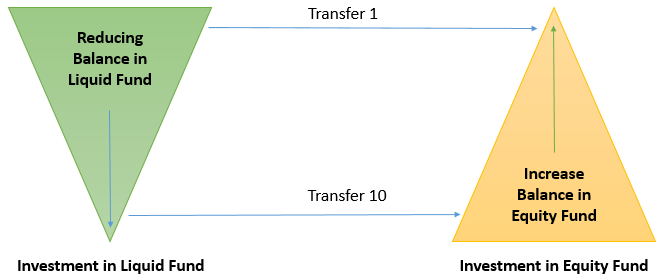
Table of Contents
What is Asynchronous Transfer Mode (ATM)?
ATM is short for Asynchronous Transfer Mode. It is a telecommunications network switching technology that employs asynchronous time-division multiplexing to pack data into tiny, fixed-sized cells.

It encodes data appropriately for TDM and sends them via physical media. ATM is the primary protocol used on the Integrated Digital Services Network's (ISDN) backbone Synchronous Optical Network (SONET). ATM networks are cell relay connection-oriented networks that enable voice, video, and data communications.
Format Types and Layers of ATM
ATM transmits data in the form of fixed-size units known as cells. Each cell is 53-bytes long, including a 5-byte header and a 48-byte payload. ATM is available in two formats, which are as follows:
- UNI Header - This is used for communication between ATM endpoints and ATM switches in ATM private networks. The Generic Flow Control (GFC) field is included
- NNI Header - It is used for communication between ATM switches and does not include the GFC, instead includes a Virtual Path Identifier (VPI) that takes up the first 12 bits
There are three layers of ATM which are as follows:
ATM Adaptation Layer
Its purpose is to isolate higher-layer protocols from ATM operations' intricacies and prepare user data for conversion into cells and segmentation into 48-byte cell payloads. The AAL protocol excludes transmission from upper-layer services and assists them in mapping applications, such as voice and data, to ATM cells.
Physical Layer
This layer corresponds to the OSI model's physical layer. The cells are transformed into bitstreams and sent via the physical media at this layer. It is divided into two sublayers: Physical Medium Dependent (PMD) and Transmission Convergence (TC).
ATM layer
It is responsible for simultaneously sharing virtual circuits across the physical connection of cell multiplexing and transmitting cells over an ATM network known as cell relay. The VPI and VCI data in the cell header are used.
Talk to our investment specialist
Applications of ATM
For a better understanding, consider the following ATM applications:
- ATM aids in the management of LAN, phone, and video services and is capable of full-service virtual private networking, which provides integrated access to multimedia
- It has two stacks of the protocol and can be used as a WAN to transfer cells over long distances, with a router functioning as an information endpoint between the ATM network and other networks
- ATM is the networking architecture of choice for installing home broadband services in quest of highly scalable solutions
- Frame relay services are utilized as a networking backbone for various data services, including frame-relay ATM services and Internetworking services
It tends to make better use of SONET/SDH fibre networks by constructing ATM infrastructure to transmit telephonic and private-line traffic.
Need for ATM in a Computer Network
ATM network is scalable in both size and strength. They offer dynamic bandwidth, which is ideal for huge traffic. Since the data is encoded into identical cells, its transmission is easy, consistent, and predictable. Here are the top reasons why it is needed in a computer network:
- ATM networks were designed to offer a wide variety of service quality at a low cost, to supplant both the telephone network and the internet eventually
- A small-sized header decreases packet overload, guaranteeing efficient bandwidth utilization
- Broadband Integrated Service Vision (B-ISON) is driven by the integration of services and the performance needs of both telephone and data networking
- Telephone networks provide a single level of service and; thus, are costly
- Uniform packet size ensures that mixed traffic is efficiently handled
- The internet does not support service quality but is flexible and inexpensive
Advantages of Asynchronous Transfer Mode
Listed below are the advantages of ATMs:
- ATM integrates seamlessly with LAN, MAN, and WAN networks
- It's designed to transfer speech, data, and video, so it's a one-stop-shop
- ATM can Handle both real-time and non-real-time traffic
- It focuses on quality of service and quickness
- The bandwidth-on-demand idea allows for optimal network resource use
- It offers the advantage of a network infrastructure that has been streamlined
ATM Vs. Data Networks
Here, you'll find the basic difference between ATMs and data networks (internet).
| Basis | ATM | Data Network |
|---|---|---|
| Meaning | ATM is a switching mechanism used by telecommunication networks that encodes data into tiny, fixed-sized cells using asynchronous time-division multiplexing | A data network is a system that uses data switching, transmission lines, and system controls to send data from one network access point to another or more network access points |
| Based On | ATM is based on "virtual circuits," which means that the path is reserved before transmission | Internet Protocol (IP) is connectionless and does not allow end-to-end resource reservations. RSVP is a new internet signalling protocol |
| Cell Size | ATM cells are fixed or tiny in size, with a tradeoff between voice and data | IP packets are varied in size |
| Address | ATM signals with 20-byte global NSAP addresses and 32-bit locally allocated labels in cells | IP employs 32-bit global addresses in all packets |
The Bottom Line
ATM is a connection-oriented protocol that could function with either Permanent Virtual Circuits (PVCs) or Switched Virtual Circuits (SVCs), depending on your WAN traffic requirements. ATM networks employ bandwidth efficiently while providing assured Quality of Service (QoS) to customers and applications that demand it. The key advantages are its fast transmission speeds and flexible bandwidth-on-demand flexibility.
All efforts have been made to ensure the information provided here is accurate. However, no guarantees are made regarding correctness of data. Please verify with scheme information document before making any investment.












